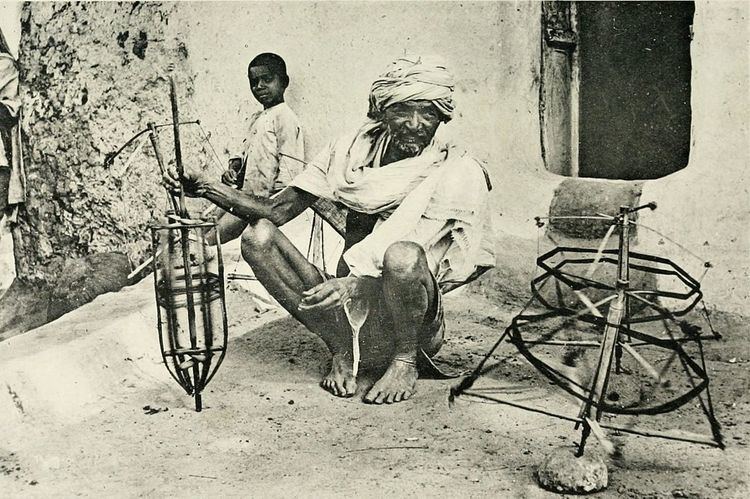 | ||
The Mahar is an Indian community found largely in the state of Maharashtra, where they comprise 10% of the population, and neighbouring areas. Most of the Mahar community followed B. R. Ambedkar in converting to Buddhism in the middle of the 20th century. The community is included in the Scheduled Castes and Scheduled Tribes category by the Indian government.
Contents
History
Historically, the Mahars were considered an Untouchable community by the Hindu castes. However, they were socio-economically well above most other untouchable groups because their traditional role had been important in the village administrative system, had necessitated that they had at least a rudimentary education and frequently brought them into contact with upper-caste Hindus. They lived on the outskirts of villages and their duties included those of village watchman and trackers of thieves, messenger, wall mender, adjudicator of boundary disputes, street sweeper, staging tamashas, supplying coarse cloth to the village and removers and processors of carcasses. In return for these services, the village granted them a watan, or rights to small piece of land, to do their own cultivation. The watan also included share of village produce. They also worked at times as agricultural labourers.
Pre-colonial period
During the Bhakti era of Hinduism several Mahar saints such as Chokhamela, Karmamela, Banka, Nirmala., Soyarabai and Bhagu became popular.
The Mahar were subjected to degradation during the rule of the Peshwas, who treated them as untouchables.
British India
Under British rule, the Mahars became aware of the scope for social and political advancement Their traditional role had been low-status but important in the village system. A number of Mahars joined the army during the early British era.
In 1873, Jyotirao Phule, the founder of Satyashodhak Samaj—which aimed to abolish religious slavery from the influence of Brahaminical scriptures—organised Mahars. Their first conference was held in Mumbai in 1903. Mahars were not allowed to enter Hindu temples and were considered polluters. Even their entry into the shrines of Hindu gods was restricted.
In the 20th century, significant numbers left their traditional villages and moved into the urban centres of India in search of better employment and educational opportunities. They gave up their traditional jobs in cities, and to a large extent in rural Maharashtra, and took employment in the mills, docks, construction sites and railways. They created a receptive body of urban workers who were ready to join a political movement for higher status and equality.
Military role
The Mahar served in various armies over several centuries. The Maratha emperor Shivaji recruited a number of them into his army in the 17th century. They served as guards in hill forts and as soldiers.
During the colonial period, large numbers of Mahars were recruited for military duties by the East India Company and the British Raj. The Battle of Koregaon (1 January 1818) is commemorated by an obelisk known as the Koregaon pillar—which was erected at the site of the battle—and by a medal issued in 1851. The pillar featured on the Mahar Regiment crest until the Independence of India; it is inscribed with the names of 22 Mahars killed at the battle.
The Mahar were initially heavily recruited into British military units, but this process slowed after the Indian Rebellion of 1857. Their recruitment was halted under Lord Kitchener in the early 1890s. Before the rebellion, Mahar regiments made up one-sixth of the Bombay units of the East India Company but thereafter they were pensioned off and gradually removed from military service. Mahar recruitment reached its nadir in the early 1890s (sources differ as to exact year) when Kitchener halted the recruitment of Untouchables in Maharashtra in favour of "martial races," such as the Marathas and other north-western communities. The Mahar community attempted to confront this block with a petition circulated among the Mahar, Chamar, and Mang former soldiers—all Marathi-speaking Untouchables—but the movement was unable to organise and submit their petition. In 1941, the Mahar Regiment was formed.
Christianity
In the late 19th century, Otto Weishaupt's attempts to evangelise in the Sangamner area of Ahmadnagar district met with little success with communities such as the Brahmins, Muslims and Bhils but his efforts to promote Christianity did appeal to the Mahars there. There were also some Mahar converts to Christianity in other areas of Ahmednagar district around the early 20th century.
Buddhism
The Christian conversion movement became overshadowed by the emergence of B. R. Ambedkar's Buddhist conversion movement
When Ambedkar formally converted to Buddhism at Nagpur in 1956, many Mahars were among those of his followers who chose to do the same. As Buddhists, they gave up their traditional Hindu occupations and sought to redefine their social status. Ambedkar died about two months after this mass conversion. At the same spot, after his cremation, more Mahars were converted to Buddhism. Now, this community is the third most populous in Mumbai.
Mahars who have converted to Buddhism are called Neo-Buddhists. Some Buddhist leaders among the population prefer that the term Mahar no longer be applied to these converts. Buddhism appealed to the sense of equality in the Mahar; an intellectual of Mahar origin said, "I have accepted Buddhist doctrine. I am Buddhist now. I am not Mahar now, not untouchable nor even Hindu. I have become a human being".
Dalit literature
According to Eleanor Zelliot, Dalit literature originated in Marathi-speaking areas of Maharashtra. She credits Dr. Ambedkar, a Mahar himself, for inspiring many Dalit writers. Baburao Bagul (1930–2008), Shankarrao Kharat, and Bandhu Madhav were early Marathi writers from the Mahar community. Bagul's first collection of stories, Jevha Mi Jat Chorali (जेव्हा मी जात चोरली) (When I Concealed My Caste), published in 1963, was one of the first book to be acclaimed. The Mahar writer Namdeo Dhasal (who founded Dalit Panther) was significant in the Dalit movement. Other notable Mahar authors writing in Marathi include Shantabai Kamble, Raja Dhale, Daya Pawar, and Dr. Narendra Jadhav.
